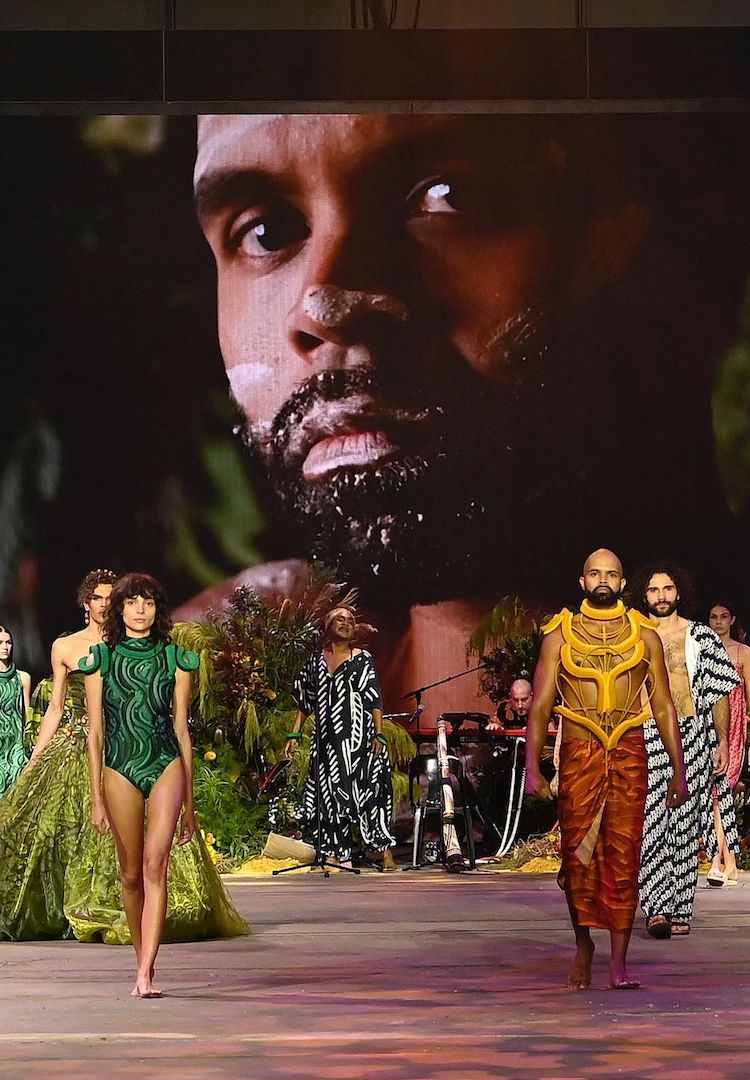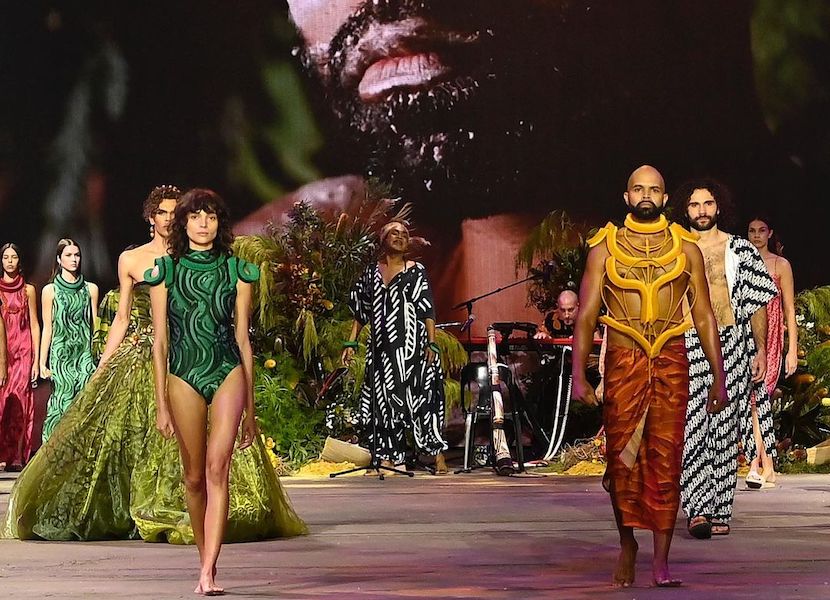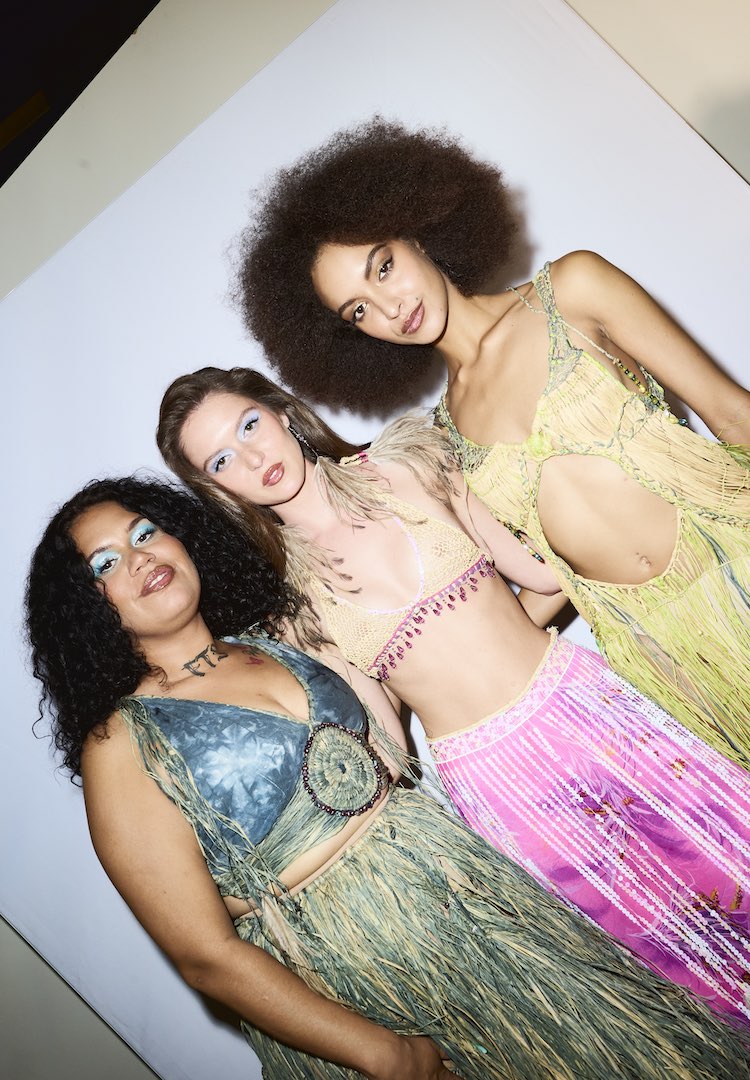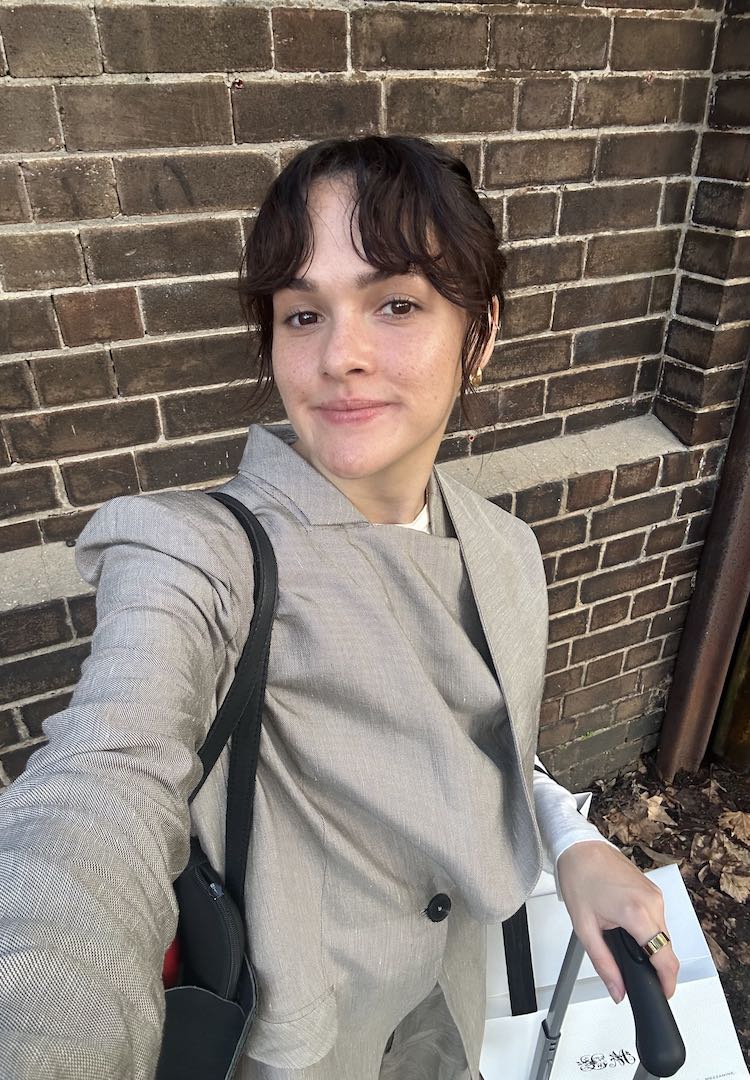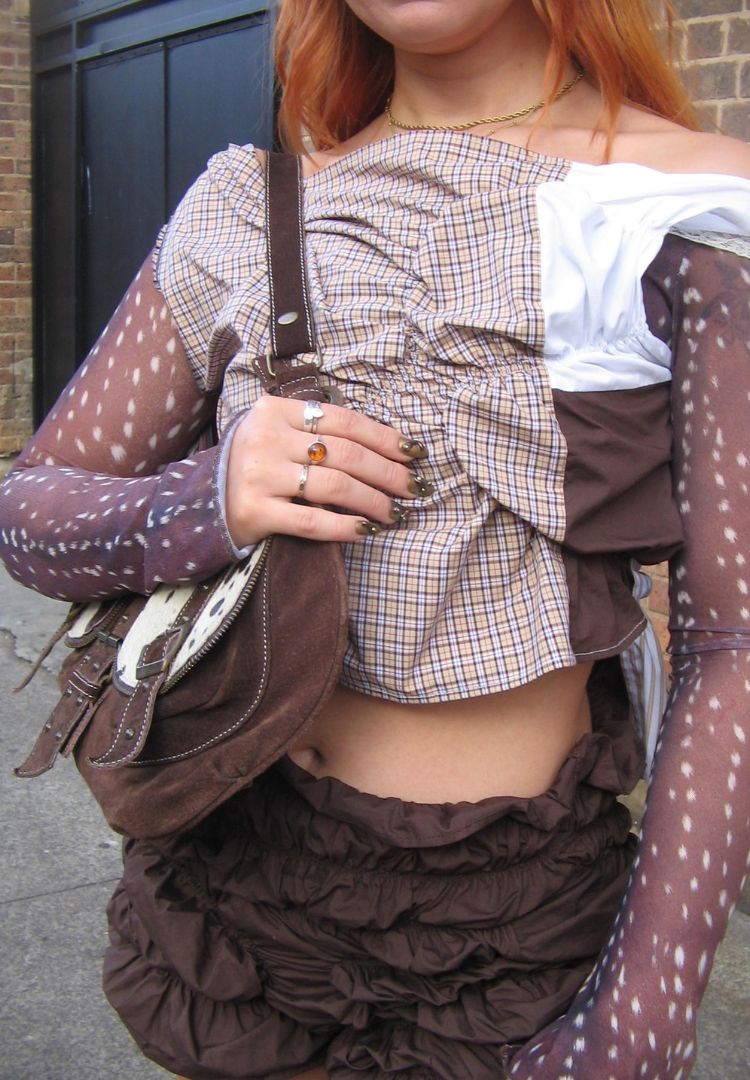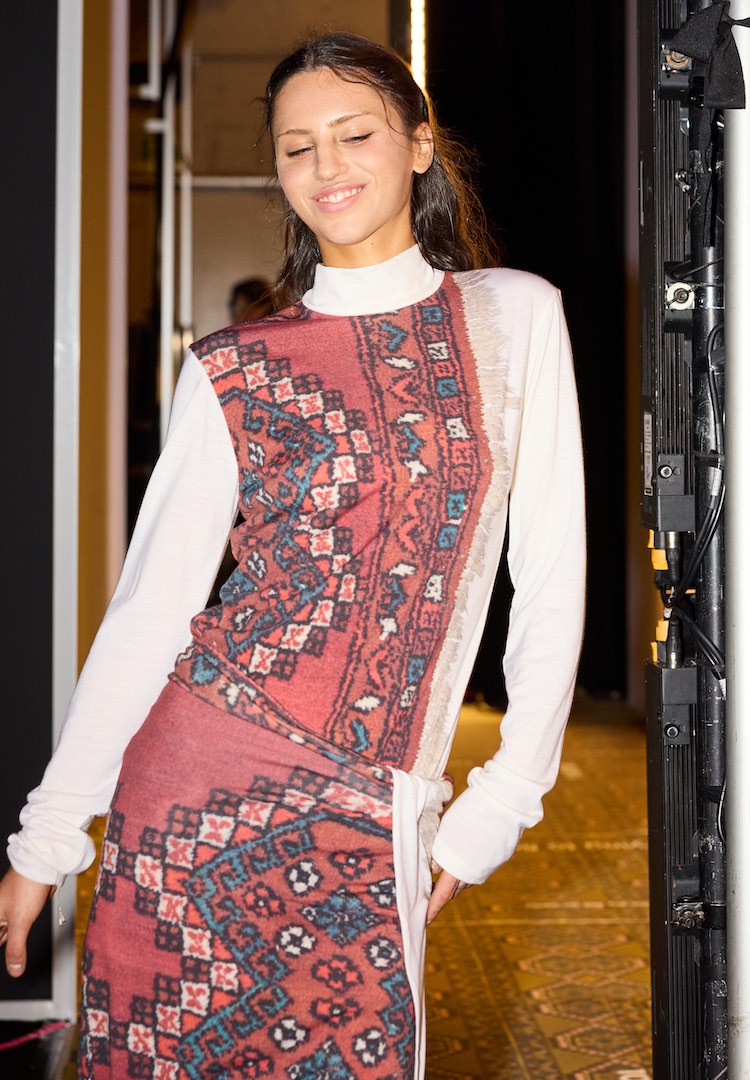Meet the two women paving the way for Blak excellence at First Nations Fashion and Design
PHOTOGRAPHY BY LUCAS DAWSON
WORDS BY ELLA TAVERNER
“It’s a complete movement and shift within the industry we’re all walking together.”
Fashion Journal is proud to continue an ongoing partnership with First Nations Fashion and Design aimed at highlighting and amplifying First Nations voices, talent, culture and stories across the industry. Fashion Journal acknowledges the Aboriginal and Torres Strait Islander peoples as the first Australians and traditional custodians of the lands on which we live, learn and work. We pay our respects to their Elders past, present and emerging.
For the Australian fashion industry, 2021 was a year of Blak excellence. In a national first, the celebrated Carriageworks multi-arts centre in Sydney saw a history-making show. Dedicated purely to First Nations creatives, it captivated the industry and media landscape at large.
At the helm stand Grace Lillian Lee and Teagan Cowlishaw (TJ), the duo paving the way for Aboriginal and Torres Strait Islander talent at First Nation Fashion and Design (FNFD). Using unbridled passion and drive to carve out a space for mob in the Australian fashion industry, the pair made waves in all corners of the nation.
Following FNFD’s breakthrough year, I had the privilege of sitting down with the two powerhouse women to hear about their experiences.
Tell me about FNFD. What does it represent and mean to both of you?
Teagan: When we first started, right at the beginning, it was about grassroots education and skill development on the ground with our mob. We saw a yearning from these artists who wanted to become designers in their own right. Together, we wanted to create a platform… I couldn’t showcase at CIAF, neither of us could do DAAF and then we had no platform nationally… So together, we were like, “we need to create a platform for our mob”.
Grace: It’s a pathway. We feel like there’s currently no organisation really supporting the development and the growth of this sector and its focus on the community, so for us, it’s a safe pathway to the fashion industry. It means the fashion industry has people to go to… to have access to Blak excellence.
TJ: I think it’s really interesting because that’s what we saw [when we started]… us just going grassroots and maybe just creating some community fashion shows – but look at what it’s become now.
Obviously, the runway at this year’s Australian Fashion Week was such a milestone for you guys and the industry. What did it mean to not only be a part of but to lead such a momentous event?
View this post on Instagram
G: You can’t describe it in words. There have been so many mob prior to us that have tried to build the sector and the industry hasn’t created a space for us. For us to be able to create this space and lead it, which wasn’t easy because we didn’t fit the criteria of an industry-standard organisation, to deliver such an incredible platform… I think that we were just a really nice gift to the industry.
They didn’t realise how impactful it was going to be. For us, it’s just amazing. Amazing isn’t even the right word to express our pride in finally arriving in the industry.
TJ: Didn’t I say, “we’re gonna make history. No one’s believing us, but we’re gonna make history”.
G: But I also think there’s a lot of mob prior to us (like Aunty Sandra King in Brisbane and Lois Peeler in Melbourne) that has paved the way… it’s because social media and the Black Lives Matter movement really amplified our voices.
TJ: I agree… And you go back to 1999, before VAMFF was at the Melbourne Town Hall, they did their first big national show where they invited 10 representatives from each state to build this national runway. So we’ve been there before. They just didn’t have social media.
G: I think it’s a true testament to my relationship with Teagan; I think a lot of people haven’t had the support and network surrounding them to enable [an initiative like this], like this isn’t funded… TJ and I are still volunteering.
But because of the greater purpose and our own purpose, because it’s for our community, that’s why we give so much of ourselves and sacrifice so much – because we see the need for it. Because if there was a space like this for us when we started, we wouldn’t have to be doing this.
As you said, I think it’s important to note you both have full-time careers outside of this and I know TJ, you have a little bubba – how do you juggle it?
TJ: Don’t you worry, I’m exhausted. I think we talk about the support we give each other because we couldn’t do this alone. We’ve both got great partners who are solid rocks at home, and we’ve got really incredible parents. Not only are they our biggest critics, but our biggest cheerleaders.
Gracie has her dad, who kind of got her into it and I’ve got my mum who did the same for me – so we’re really following in the footsteps of them. We’ve got incredible communities, and then a national community. That’s what keeps us going.
G: I think the national community, the people we work with across the nation who are longing for a space of connection and understanding – we’re all trying to do the same thing. It’s not just that we’re trying to push a commercial outcome – while it’s great and helping to build economic independence – but it’s a complete movement and shift within the industry we’re all walking together.
Just going back to what you said about your parents, it sounds like this was always organically instilled in both of you. You obviously both have that fire in your belly from your parents and family, and it feels like such a natural pathway.
View this post on Instagram
G: When TJ talked about her mum putting on fashion shows in the community, I was like “oh my god”. Just seeing the movement she’s created in the NT is incredible. She was the first woman to hold Indigenous fashion awards – before the National Indigenous Fashion Awards even existed.
TJ: I’d say she’s the first person to link up with an Australian designer to establish an Aboriginal community collaboration in the NT, like with Linda Jackson.
G: Yeah, she was already paving her own path, which positioned TJ in a great way. Then I think about my mum – she was a hairdresser and I was surrounded by hair shows my whole life. And my dad supported Aboriginal and Torres Strait Islander artists by having a gallery.
I know there’s so much you both put into this behind the scenes. What does this look like?
G: At the moment, day-to-day, we’re trying to build the foundations and find the resources to run our not-for-profit organisation. It’s really about applying for funding, finding the right partnerships and stakeholders with aligned values that can come along on this journey with us. We’ve obviously created a lot of impact and noise, so people can see the potential of where we want to take this.
We need support, we’re not currently funded so we don’t have any government – federal, state or local – funding. TJ and I are investing our time in the organisation because we believe in it. We hope we can get more support to grow this space because we already have such incredible projects coming up that we’re locking in.
But we’re more concerned about the foundations – building an ecology that feels supported when entering into the fashion industry. So we do this through fashion shows by creating access.
TJ: We want to kind of change this to a long-term approach because at the moment it’s just project-based. What we want to do is start building the foundations of the organisation, so then we’re starting to actually employ Aboriginal people and providing annual salaries for mob.
Not only for us but for others, because we know there are skilled mob out there, I just don’t think there have been positions available in the industry for them. So not only are we able to create those pathways to get those industry internships, but offering positions with us when we can eventually get paid… look out when we actually have a team.
G: And we’re doing this through our hubs. So we’re starting a hub up in Far North Queensland in Cairns in the TAFE, and we’re hoping to have one in Sydney and one in Melbourne.
In terms of day-to-day work, TJ and I are meeting a lot of people around future potential partnerships, doing a lot of business planning, strategic planning, learning governance and managing our talent… we’re working to create further opportunities, and then trying to connect with the industry.
What are your hopes and dreams for FNFD? What are your goals for the future?
View this post on Instagram
TJ: We want to get a five-year partnership with the Powerhouse Museum, we’ll then be able to acquire and document everything for the next five years. We would create fashion history there.
G: I think our main focus is setting up a sustainable foundation, so we’re fully funded and we only have to rely on ourselves. I think that’s one of our top pillars. Our second would be a First Nations fashion festival, which is something we’re walking towards but want to build up gradually; we understand it costs a lot of money.
Are we going to see some exciting things happening in 2022?
G: Of course! There are huge things happening in 2022 which we’ve already started organising – we’re hustling!
To learn more about Grace, TJ and First Nations Fashion and Design, head here.


